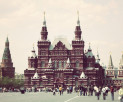Semi-permeable borders
It has been a year since I visited Mother Russia for the first time and then travelled through Ukraine by transfer. I was residing in Moscow when the tragic incident of MH17 happened. This semester, I have returned to the Third Rome (prophetic name for Moscow) to study at the Higher School of Economics.
After I had charged my battery at a shady Starbucks look-a-like café, I was able to locate my dorm with the help of the free WiFi in the metro which, unlike the worthless NS WiFi, works perfectly fine. My Moscow experience was about to begin.
Russia, together with IS, has been dominating the news this past year. The Ukraine crisis, the sanctions, the Arctic Sunrise and recent prosecution of a Ukrainian filmmaker and an alleged Estonian spy are just a few issues that made the headlines. Many even dub the new situation a return to the Cold War.
Times have changed and the time of the CW is over. However, it cannot be denied that there are certain aspects that remind us of the past. Take the recent decisions by Estonia and Latvia to build fences on their borders with Russia, for example. These are projects that cost over 90 million euros. These Baltic States justify their decision by referring to the inflow of illegal immigrants from Russia and the smuggling of tobacco and booze. These arguments are soon rebuked in the Russian newspaper Metro, which cites an official at the ministry of defence who claims that the measures are ‘purely political’. This is only one of many examples of the media war that is still raging.
When thinking about border protection, one easily remembers the sanctions imposed by the EU on Russia and vice-versa. Established in the wake of the Ukraine crisis, they have had a significant impact on the life of ordinary Muscovites. As student Sofia Tsareva puts it, ‘It’s not that stores are visibly emptier, it is just that some products have increased massively in price.’
She specifically refers to the Russian ban on certain products from the EU, such as cheese. ‘The labels are replaced and the products are imported as Belarusian goods’, she says.
Another issue that bothers the population, especially the youth and internationally-oriented business people, is the falling ruble exchange rate. Last summer, you could buy approximately 45 ruble for one euro, whereas a few days ago, it was almost 80.
For someone like Sofia, this means that her exchange with a French university is unaffordable, but she remains positive: ‘I really hope this will all be over after a few years so I can do my master’s abroad.’ Not only Russians are affected, as a Dutch businessman complaining about how difficult it is to break even proves. He remains generally positive when he shares his expectations, though. ‘We just have to sit out this crisis and things will get better in a few years.’ On the other hand, this lower ruble exchange rate means cheap living for European exchange students, since price inflation has not yet followed suit.
The people I have spoken to seem not to worry about the sanctions that much, and history has proven that the Russian people have endured more than economic sanctions. The general mood in Moscow doesn’t seem to be as tense as I would have guessed before, which is hopefully something that will not change during my stay.




